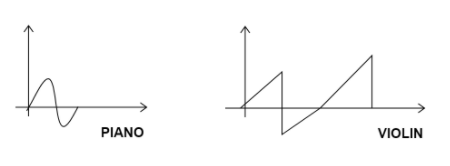Question
Question: Two musical notes of the same pitch and loudness are played on a violin and a piano. The waveforms a...
Two musical notes of the same pitch and loudness are played on a violin and a piano. The waveforms as shown in the figure are given below. Explain why the wave patterns are different.

Solution
The musical notes are played even on the same pitch and loudness has different waveforms because the type of sound from the two instruments is different. The quality of sound plays an important role in determining the type of waveform.
Complete answer:
Sounds from different instruments even when they are of the same pitch and loudness because of the quality of sound or the tone differs with the type of instrument.
In the case of any sound, there does not exist only one frequency that sounds are not made of only pure notes. Every sound consists of the main note and various other smaller notes.
The smaller notes are known as overtones or harmonics.
Every sound has harmonics in it, the only exception being in the case of a tuning fork.
The main note present in the sound is known as the fundamental and the first overtone is known as the first harmonics, the second overtone is known as the second harmonic, and so on.
Since the sum of these harmonics differs in the case of the piano from that of the violin, the tone or quality of sound in both instruments are also different.
Hence, the waveform of sound produced from the two instruments is different.
Note:
In the case of a tuning fork, there is only fundamental and no harmonics. This is because the sound from the tuning fork is produced due to vibrations and the tuning fork emits pure sine waves at a single frequency. Due to this, the sound emitted by the tuning fork is pure and free from harmonics.
